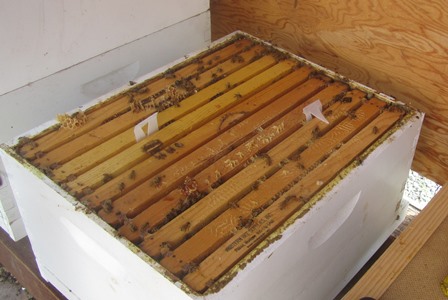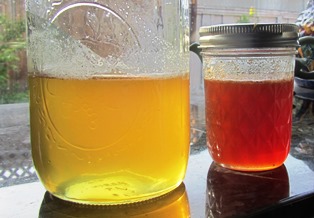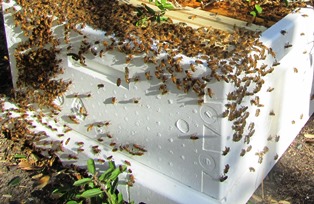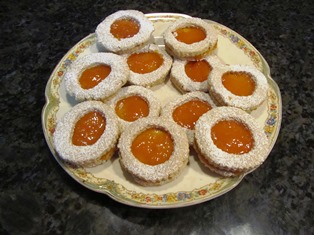Preparing Honeybee Hives for Spring
Recently, I conducted a mid-winter check of my honeybee hives. With my beekeeper neighbor’s help, we opened my Henny Penny Farmette Hives A and B to search for signs of an increase in the mite population, the presence of other pests, and evidence of mold. Inspecting and treating bees with medicines when necessary are important bee management practices.
We found one bug that I couldn’t identify but my neighbor explained it lays a narrow worm and must be removed before its numbers increase. This we did. We also found three frames in Hive B that had a few spots of mold. We threw away the frames and replaced them with wax-covered frames in the lower hive box where the queen had already produced lots of bee babies.
There appeared to be adequate stores of honey, baby bee food, and lots of baby bees. In fact, we removed a few frames of honey from both hives. In their place, we inserted frames that previously had the honey drained off but wax left intact (these I always freeze before putting back into hives since freezing kills mites, larvae, and wax moth), making it easier for the bees to start building comb.
The honey I harvested is dark-colored and earthy tasting, typical of autumn honey when the bees collect pollen from eucalyptus, star thistle, and other sources available in autumn. In contrast, spring honey is light-colored and slightly citrus tasting from pollen gathered from blooming citrus trees and wildflowers.

Hang medicated miticide strips between frames inward from the edge of the hive box for mite control.
Since we found evidence of mites, we hung miticide strips between frames to combat tracheal and Varroa mites. Also, we sprinkled powdered sugar medicine (Tetra-Bee Mix 2X Medicated) over the frames to control risk of American foulbrood. Treating the hives thus will enable the bees to remain robust. I expect their numbers to swell with warmer weather which, in turn, translates to new swarms in the spring.
*Apivar is an effective treatment of Varroa mites. One strip per four to five frames works through contact and should be placed in high bee activity areas. Not to be used when honey supers (top hive boxes with frames of honey) are on.
*Tetra-Bee Mix 2 X Medicated is recommended for control of American foulbrood caused by paenibacillus larvae and European foulbrood caused by streptococcus pluton susceptible to oxytetracycline in bees when used as directed.
For more beekeeping tips, delicious recipes, and a wholesome whodunnit, check out my Henny Penny Farmette cozy mysteries: A BEELINE TO MURDER (paperback release in October 2016), MURDER OF A QUEEN BEE (hardcover October 2016), and HIVE OF HOMICIDES (October 2017). Find them on Amazon.com, Barnesandnoble.com and other online and conventional bookstores everywhere.
Honeybee Hive Pests Include Real Vampires
Every beekeeper wants to keep his or her hives healthy. Staying on top of your bee’s health means early detection and treatment of pests in the hive such as Varroa mites, trachea mites, hive beetles, and wax moths.
Varroa mites–these small reddish brown pests are akin to tiny vampires, feasting on your bees’ blood. Non-medicinal approaches to treating for these mites include introducing a screened bottom board. Mites fall through and cannot re-enter the hive to reattach to the bees. Also a powdered sugar dusting of your hives’ top bars can dislodge mites.
Tracheal mites–these pests are more difficult to detect. My beekeeper neighbor showed me infant baby bees with partial wings and said he believed it was the work of tracheal mites. To rid your hives of these pests, you’ll need to use menthol crystals and grease patties.
Hive beetles–if you see an insect with a hard, small black shell in corners and dark places within the hive, you may have hive beetles. They devour bee brood, honey, wax, and pollen. Treat the soil in front of the hive and inside the hive, you can try hive beetle traps or treat chemically. The infected honey will be rejected by the bees and should be considered unfit for human consumption as well.
Wax moths–these nasty little creatures can been seen in honeycomb and leave a silky trail over your hive’s hanging frames. If you see evidence that they’ve tunnel into the wood, know that you’ve had the infestation for a while. Wax moths will weaken a colony. Treat the infected hives with moth crystals formulated to eliminate wax moths in the hive.
Hives that are frequently checked their beekeepers stand the best chance for having healthy colonies of bees.
Apricot Linzer Cookies
I’m a self-professed cookie monster. I can’t imagine watching PBS’s MASTERPIECE MYSTERY! without a cup of my favorite Earl Grey tea and a cookie. Okay, maybe two cookies And my favorite is actually a two-layer, jam-filled cookie. These cookies are known as Linzer sablés and are the cookie version of the famous Austrian Linzertorte, dubbed the world’s oldest known cake (torte is Austrian for cake, Linzer is forLinz, a city in Austria).
The top cookie and bottom are made of the same nut-flour dough; it’s just that bottom cookie is solid, whereas the top has a hole in the center (to reveal the jam filling). The dusting of powdered sugar on top gives the cookie a lovely professional look.
They are easy to make and are pretty enough for a tea party. Choose different shapes of cookie cutters for the ring cutout. Some specialty shops carry Linzer cookie cutter sets. Use a heart shape cutter to make Linzer cookies for a wedding reception, anniversary party, or Valentine’s Day; a pumpkin or witch’s hat shape for Halloween; or, stars for the Fourth of July and also Christmas. The jewel jam color doesn’t just hold the cookie together; it emphasizes the cutout shape.
Ingredients:
9 Tablespoons unsalted butter (equivalent of 1/2 cup, plus 1 Tablespoon)
1/2 cup granulated sugar
2 egg yolks
1/4 teaspoon vanilla extract
3/4 cup almond flour
3/4 hazelnut flour
2 1/4 cups pastry flour
apricot jam for filling
powdered sugar to sift on top
Directions:
Set oven to 350 degrees Fahrenheit, but wait to do it until after you’ve made the dough and chilled it for one hour.
Combine butter and sugar in a mixing bowl and cream until light and fluffy.
Add one egg at a time and beat into the mixture.
Add vanilla (alternatively, bitter almond).
Add to the mixture the almond flour, hazelnut flour, and pastry flour and combine.
Cover and refrigerate for a minimum of one hour.
Roll the dough out on a lightly floured surface to 1/8 inch thickness.
Cut circles out of the dough using a three-inch round cookie cutter.
From half of the circles, take a one-inch round cookie cookie cutter and cut out a center hole, forming a ring.
Place rings and circles on an ungreased baking sheet.
Bake in the center of the oven for 7 to 10 minutes. They should appear golden brown.
Remove and allow the cookies to cool.
Assembly:
Spoon a dollop of jam on each solid circle and spread it evenly over the top.
Place a ring on top of each jam-coated circle.
Lightly dust the tops of each ring.
Makes approximately 4 dozen cookies
 Facebook
Facebook Goodreads
Goodreads LinkedIn
LinkedIn Meera Lester
Meera Lester Twitter
Twitter











